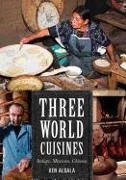Read more
The textbook begins with a comprehensive theory of cuisine in the introduction and moves to the parallel culinary histories of Italy, Mexico, and China: the independent domestication of crops in each, the social, political, and technological developments that gave rise to each cuisine, and cooking in both professional and home settings. It also compares the internal logic of the cooking style and techniques in a way that will resonate with students. The meat of the text compares and contrasts the three cuisines in chapters on grains and starches; vegetables; fruits and nuts; meat, poultry, and dairy products; fish and shellfish; fats and flavorings, and beverages. Students are taken on a fascinating journey of discovery, where the background story of mis-transmission, adaptation, and evolution of cooking as it spreads around the globe with trade and immigration is revealed. It answers the big questions, such as, why did the wok prevail in China, while the sautee pan and comal were used in Italy and Mexico, respectively? Why is bread baked in the Mediterranean but more often steamed in the Far East?
How are certain ingredients used in completely different ways by different cultures and why? Why is corn transformed into tortillas and tamales in one place and into polenta in another? Why do we find tomato salsa in the Americas, long-cooked sauces in Italy, and tomatoes mixed with scrambled eggs in China? Albala also challenges the notion of authenticity, providing ample evidence that cuisines are constantly evolving, adapting over time according to ingredients and cooking technologies. More than 150 of Albala's recipes complete the instruction, inspiring students to learn how to cook in a fundamental way.
List of contents
List of Figures List of Recipes A Note on the Recipes Introduction: A Theory of Gastronomy Chapter 1 Historical Background Chapter 2 Technology, Utensils, and Techniques Chapter 3 Grains and Starches Chapter 4 Vegetables Chapter 5 Fruits and Nuts Chapter 6 Meat, Poultry, and Dairy Products Chapter 7 Fish and Shellfish Chapter 8 Fats and Flavorings Chapter 9 Beverages Glossary Bibliography Index
About the author
Ken Albala is professor of History at the University of the Pacific in Stockton, California, where he has taught courses on food history, and also teaches in the Gastronomy program at Boston University. He is the author of many books on food, including Eating Right in the Renaissance (2002), Food in Early Modern Europe (2003), Cooking in Europe, 1250-1650 (2005), and Beans: A History (2008). His co-authored cookbook is The Lost Art of Real Cooking (2010). Albala has also edited or co-edited a number of works such as the Food Cultures of the World Encyclopedia and served as series editor for Food Culture around the World and Cooking Up History series. He is the general editor of AltaMira Studies in Food and Gastronomy and the co-editor of the journal Food, Culture and Society.
Summary
This "living" text provides readers with a solid understanding of the three cuisines that have had the greatest impact on the globe historically. Deep knowledge of Italian, Mexican, and Chinese cuisines illuminates many of the great historical themes of the past 10,000 years as well as why we eat the way we do today.

